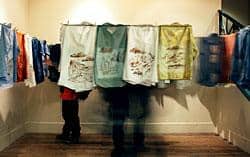Project Background: The Chinese laundry is an iconic thread of the early China-to-US immigration story. It was a business that required little start-up capital or spoken English and was viewed as an undesirable task that could be passed on to immigrants without controversy. Regardless of professions they may have attained before coming to the U.S., many Chinese immigrants found this particular small business to be one of the few career options open to them in their new country.
Although the laundry business and immigration patterns have changed a great deal in the last 100 years, in a broad sense, jobs with “laundry” roots still represent work that a wide variety of immigrants find easily accessible regardless of past experience—dry cleaning, housekeeping in the hospitality industry, and private housecleaning services often have a disproportionate number of immigrants filling their ranks—once again doing difficult, lower wage work that more established Americans are happy to pass on. Since our work is such a large part of our identities, a transition in profession brought on by immigration, be it permanent or temporary, can bring about dramatic changes in identity.
Project Description: Using the Chinese laundry as a jumping-off point, artist Shu-Ju Wang will present The Laundry Maze in the Portland Building Installation Space from February 13th through March 16th, 2012. As she began her research, the artist found that immigrants continue to compromise and take on jobs with less prestige as they resettle; those with the most training and the most prestigious jobs in their native countries are generally the most impacted. But the results were more varied than she had initially anticipated—over time quite a few immigrants surveyed were able to make lateral transitions to jobs comparable to those held before immigration, and a few who took on positions with lower responsibility elected to keep those “lower stress” positions.
Drawing on the idea of unseen figures moving from place to place, uncertain of where they will be led next, Wang will create a simple maze inside the installation space. Clotheslines will be installed in a grid pattern with various shirts and blouses hung upon them to define the maze. Sets of “before and after” job descriptions, inscribed on the clothing (or “laundry”) will document the variety of profession transitions that immigrants have volunteered to share with the artist. With their faces and identities obscured from outside view by the maze walls, visitors to the Portland Building will be encouraged to find a path through the maze as they read and share the identity shift experience that immigration demands.
Viewing Hours & Location: 7 am to 6 pm, Monday – Friday. The Portland Building is located at 1120 SW 5th Avenue in downtown Portland. For more information on the Portland Building Installation Space Series including images, proposals and statements of all the installations selected since 1994, go towww.racc.org/installationspace.
